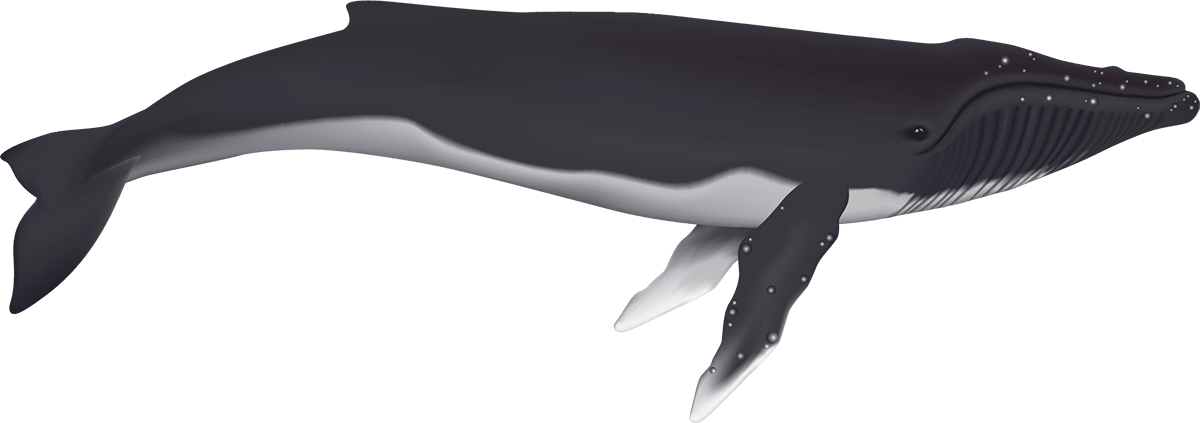Humpback Whale Fast Facts
Scientific name: Megaptera Novaeangliae
Class: Mammalia
Average length: Up to 60 feet
Average weight: Up to 40 tons
Current population: At least 80,000
Cruising speed: 3 to 10 miles per hour and up to 15 mph
Gestation period: 11 months
Favorite snack: Krill Pot Pie
Favorite tunes: Pentatonix
Favorite pastime: Genealogy, beatboxing, and deep sea stamp collecting

Humpback Whale
Humpback Whales: Dive Deeper
In an underwater world of creatures that range from spotted seals, sharp-toothed sharks, cutesy cool cetaceans, to magnificent Mola mola, jovial jellyfish, and chic crustaceans, there is one marine mammal that not only leaves its deep-sea peers in awe, but gives our own fellow human folk a reason to sport our favorite oohs and ah’s. The recipient of our snazzy salvos goes to our hefty and handsome ocean pals, the humpback whales.
These awe-inspiring gentle giants are not only famously known for their 40 ton selves, and knobbly heads, but there is a plethora of other reasons why we are smitten with their beauty and crave their attention during our daily whale watching safaris.
What do Humpback Whales Look Like?
Humpback whales, scientifically known as Megaptera Novaeangliae, (Yep! We didn’t say it right the first time, either,) are baleen whales. In addition to sparing our tongues from a tricky game of twister, these baleen whales were given their nickname “humpback” from the distinctive hump on their back, instead of a typical dorsal fin seen on other large whales, as well as from the way their back curves when diving down into the water from the surface.
One of the largest rorqual species, they grow to a length of 60 feet and weigh up to 40 tons. Their 80,000-pound physique has us feeling a bit better about ourselves after we finish up that hefty burrito, and although they are one of the largest whales, they are well known for being graceful, energetic, and lively. Often putting on spirited shows for land loving onlookers, humpback whales can be seen breaching, lobtailing, and fluking.
Exhibiting a head that is broad and rounded, they are glammed up and easily distinguishable by the several plus fist sized knobs which are speckled about their massive noggins, particularly around the mouth area. These knobs are called tubercles, and each of these bumps contains at least one hair. The purpose of the hairs is uncertain, but researchers believe they may aid in motion detecting, as well as self-confidence with the males when showing off the stash to the pals on the swim team. (The ladies bowed out on disclosing their opinion regarding the scruff on the chin-a-lin.)
Sporting up ventral pleats which run from the tip of the lower jaw to the belly, and resemble the likeness of an accordion, these pleats give the whales yet another unique physical characteristic, which greatly aids them in their feeding habits, as well as with their swipe righter fan club on tinder.
Their long pectoral flippers, which can reach lengths of up to 15 feet long, and are proportionally the longest of any cetacean, can be seen slapping against the surface of the water, and most likely take the crab cake for the best high fives and fist bumps on the planet. These long pectoral flippers were what inspired its scientific name ‘Megaptera’ meaning “big-winged.” We’ve yet to receive a solid fist bump from these big-winged fellas, but that doesn’t diminish our excitement when we spot their large, dark grey and black colored whale-selves throughout the year.
Each humpback is unique, and the pattern of pigmentation on their tail flukes, along with the shape of their tails, provide scientists a way to identify each individual whale. In fact, this unique characteristic has enabled us to spot our most favorite “resident” humpback whale, “Brutus.” For ten weeks, Brutus made almost daily appearances, delighting our passengers and crew with playful antics. The unique coloring on his tail, as well as its shape, helped us to recognize him as he brilliantly impressed us with his stellar shenanigans. (Brutus was quite thrilled when he found out that we could recognize him by his charming skin tone, as he was highly considering a pink wig to better be seen.)
Where do Humpback Whales Live?
There are fourteen distinct populations of Humpback whales. In addition to the ones that make visits to the west coast and Southern California area, a few well-known populations primarily breed and aloha it up in the main Hawaiian Islands, and feed in Southeast Alaska and northern British Columbia. The western north pacific population breeds in Japan and the Philippines, and feeds primarily off the Russian Coast where they often pop into the babushkas for Sunday dinner. There is also a Central American population which breeds along the Pacific coast of Costa Rica, Panama, Guatemala, and other South American areas, and feeds almost exclusively off California and Oregon. These whales travel extraordinary distances during their seasonal migrations, with several humpbacks traveling over 5,000 miles, some completing their migrations in less than 36 days!
There are two populations of humpback whales whose summer feeding grounds spread across the North Atlantic, from the Gulf of Maine to Norway. They head south to their winter breeding areas in off in the West Indies and Cape Verde.
The only population of humpback whales that do not migrate can be found in the Arabian Sea. They are endangered and there may be less than 100 individuals.
What do Humpback Whales eat?
The waters along the coast of Southern California play host to these beauties, as they leave their winter feeding grounds in the arctic for warmer, much cozier waters in Mexico where they breed, give birth, and nurse their young. The rich, nutrient-filled waters off of Dana point provide a delectable dinner bowl full of small fish as well as crustaceans such as krill.
The humpbacks have several forms of feeding, but a common feeding practice includes a routine called “bubble feeding.” Several whales blow bubbles through their blowholes, and sport up a game of ring around the rosy, as they trap their prey in the center of the bubble “net.” The whales then swim right up through the center of the bubbles and gobble up their prey. They do this by taking large amounts of krill, and or other small crustaceans and fish, into their accordion-like jaw area, and strain the ocean water through their baleen plates, leaving their bellies full of this delectable menu item. Humpbacks can eat up to 3,000 pounds per day! That’s the equivalent of eating over 12,000 tacos WITH extra cheese, sour cream aaand guacamole. Sign us up!
Humpback Whale Singing
Playful antics, a yummy bubble bash, mommy-me time, and a good taste in hair color, are not the only spiffy skills these graceful giants care to share. Humpback whales are well known for their astounding melodic jingles. Humpbacks produce extraordinary and complex sounds that can be heard hundreds of miles away.
While both male and female whales vocalize, only the males really get priming up the pipes as they create cradle worthy lullabies that last anywhere from 10 minutes to hours on end. The sounds include groans, cries, and howls, and although those words don’t seem to describe the most lovely nursery rhyme, the combination of sounds within their underwater world create a composite of melodies that are soothing and appealing to the human ear. (We also hear that their Prince impersonation is impeccable.) Their beatboxing jams are so powerful, and so loud, that folks with feet who have had the opportunity to dive close to these giants, have literally been vibrated from the inside out. Scientists are unsure of why these whales produce such breathtaking beats, but they believe it may be a flirtatious tactic to attract females for breeding, as males are the only ones who sing.
Humpback Whale Reproduction
Nothing quite compares to the endearing love exemplified by a tender mother humpback with her growing offspring. Carrying a calf for just shy of a year, mother humpbacks give birth to whales that are 10 to 15 feet long and weigh up to one ton. Mother and baby stay closely connected for the first year of the calf’s life, all while the baby consumes 150 gallons of mother’s milk per day, the richest of any mammal, helping the baby to gain at least 55 pounds per day.
The closeness between the two is nothing short of prepossessing. Scientists have recorded communication that reveals baby whales “whispering” to their mothers, and the physical connection between the whales is gentle and compassionate. The baby often rests underneath the body of its mother, as its body is far too buoyant to stay stationary on its own. Even though the mother weighs over 40 tons, she demonstrates a tenderness with her calf that belies her magnificent power and proves to us how gentle these giants really are.
Threats to Humpback Whales
With all these winged whales have to offer, one may wonder why these mammals were hunted to the brink of extinction less than 100 years ago. Due to commercial whaling, over 200,000 humpbacks were taken, reducing the global population by over 90%.
Thankfully, in 1946, The International Whaling Commission imposed hunting regulations and created hunting seasons. In 1966, commercial whaling was officially banned bringing their numbers up to about 50 – 80,000 whales worldwide.
Although laws and regulations were put in to effect to protect the lives of these graceful giants, they still encounter threats to their population. From entanglement in fishing gear, ship strikes, ocean noise, and habitat impacts, humpback whales tend to stay on their tail toes when coasting the deep blue. Many measures are being taken to protect these magnificent creatures but the threats are very real, and in many places, humpbacks are an endangered species. Many changes still need to be made in order to protect the place they call home.
How grateful we are that they choose to share their underwater home with us, and put on a great welcome show while they’re at it! Humpback whales are generally curious about nearby objects, including us, and approach our whale-watching vessels closely, often getting comfy cozy under or near the boat for several long minutes. Their curious glances and close snuggle boat visits are usually preceded by thrilling spyhops, and other riveting rollicks which leave the spectators speechless. Best part? These charmers can be spotted any time of the year here in Dana Point! So, if you’re in the mood to have your breath taken away, come aboard as we sail into the ocean blue to enjoy our beautiful Southern California coastline while sporting our favorite oohs and ahhs for our favorite awe-inspiring giants.
See you soon, Megaptera Novaeangliae mateys! (It’s okay, we’re still trying to say it right, too.)

